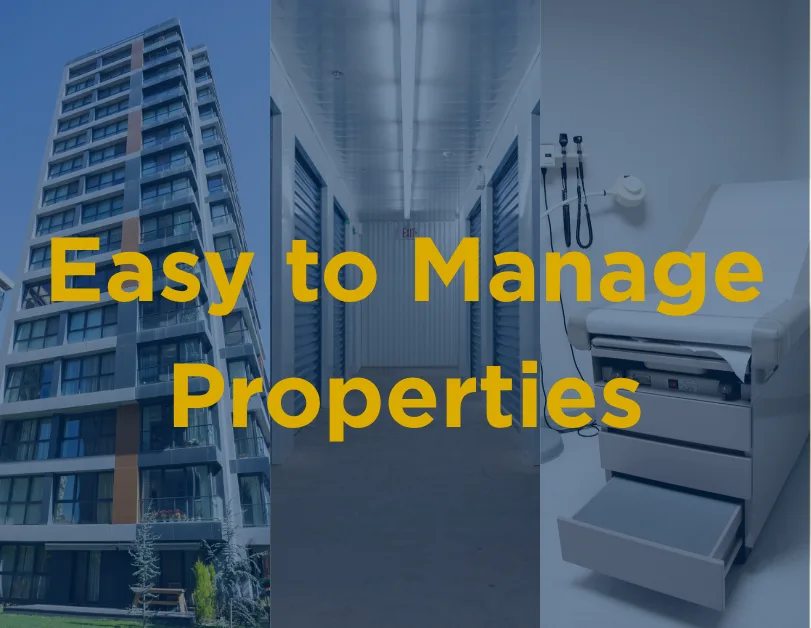Real estate investors often dream about consistent returns with minimal headaches. The reality is that some properties require constant attention, while others practically take care of themselves. Choosing the easiest property types to manage can make your ownership experience smoother, more predictable, and far less stressful.
Let’s look at three asset classes that are generally easier to manage and maintain over time.
Class A Apartments: Reliable Tenants, Low Maintenance Buildings
Among apartment buildings, Class A properties rank at the top of the list when it comes to simplicity. They’re newer, more efficient, and attract tenants with stable incomes. These factors combine to make them one of the easiest property types to manage in residential real estate.
Newer construction brings fewer repair issues. You won’t be dealing with leaky pipes, failing HVAC systems, or old roofs that require ongoing maintenance. Fewer breakdowns mean fewer calls and less time coordinating with contractors.
Tenant quality also plays a big role. Residents in Class A properties tend to have stronger financial positions and are more likely to pay their rent on time. They value a clean, comfortable space and generally take care of their space. Turnover tends to be lower, which means less time spent re-leasing units.
The main tradeoff is that these tenants sometimes have higher expectations. Their complaints might seem minor – such as noise interrupting their early-morning yoga, or small aesthetic issues – but they expect fast responses. Even so, the day-to-day management load remains far lighter than with older or lower-quality properties.
If your goal is to own apartments that generate steady income with minimal surprises, Class A assets are one of the easiest property types to manage.
Self-Storage: Streamlined and Straightforward
Self-storage has become a favorite for investors who want a simple and scalable investment. It’s one of the easiest property types to manage because operations can be streamlined, maintenance is limited, and automation can handle most tasks.
At its core, a self-storage facility is a set of durable metal units with few moving parts. There are no plumbing systems to maintain or tenant issues to mediate. Most maintenance involves cleaning, lighting, or occasional repairs to doors and locks.
The biggest efficiency for self-storage comes from automation. Many successful operators allow customers to rent units, make payments, and access the property online without ever needing to interact in person. When the system is set up correctly, management becomes more about supervision and less about daily involvement.
Of course, the opposite is true if you skip automation. Manually handling leases and payments for dozens or hundreds of small tenants can quickly become overwhelming. The difference between a high-efficiency facility and one that drains your time comes down to technology and systems.
When designed well, self-storage can operate with minimal oversight, steady income, and predictable expenses. It’s a prime example of the easiest property types to manage for investors seeking hands-off ownership.
Certain Commercial Properties: Stable and Sticky
Commercial real estate is a broad category, and not every property in it is simple to manage. But some stand out as part of the easiest property types to manage, particularly those with long-term tenants who invest heavily in their own spaces.
These are tenants with specialized needs – dentists, medical offices, or manufacturers – who spend significant money building out their space. Because moving would require major expense and downtime, they tend to stay for years. These “sticky” tenants create stable income and reduce turnover.
Industrial properties often fall into this category as well. A company that relies on high-power electrical capacity, reinforced flooring, or specialized loading areas won’t easily find a replacement property. That stability translates to less work for the landlord and longer lease terms.
Another reason certain commercial properties are easier to manage is the lease structure. Many use net or triple-net leases, which shift maintenance and operating costs to the tenant. That means the tenants are responsible for things like repairs, taxes, and insurance – leaving the landlord with fewer obligations.
Retail properties, on the other hand, can look easy at first but carry more risk. Retail tenants depend heavily on consumer trends. When those trends change, even well-known brands can close if they don’t evolve. Blockbuster Video is a classic example of this phenomenon. So while some retail properties can be steady, they generally require more monitoring and re-leasing over time.
The key takeaway is that the easiest property types to manage in the commercial world are those with specialized, long-term tenants and strong lease structures that minimize landlord responsibilities.
Final Thoughts
Finding the easiest property types to manage isn’t just about convenience – it’s about building a portfolio that’s sustainable for the long term. Class A apartments reduce maintenance calls and attract reliable tenants. Self-storage, when automated, can run with minimal hands-on effort. Certain commercial properties with stable, long-term tenants can provide dependable income and limited upkeep.
Every investor’s goals are different. Some prefer to be hands-on, while others want their properties to operate quietly in the background. By choosing the property types that align with your ideal level of involvement, you can create a smoother and more rewarding investment experience.
Many investors we work with appreciate our guidance on which property types fit their investing goals. If you are exploring commercial or multifamily opportunities in Pennsylvania or Maryland, contact us to discuss your goals and the options that can help you reach them.





